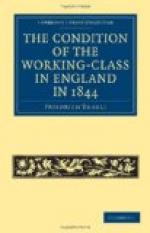“But let all men remember this—that within the most courtly precincts of the richest city of God’s earth, there may be found, night after night, winter after winter, women—young in years—old in sin and suffering—outcasts from society—ROTTING FROM FAMINE, FILTH, AND DISEASE. Let them remember this, and learn not to theorise but to act. God knows, there is much room for action nowadays.” {32}
I have referred to the refuges for the homeless. How greatly overcrowded these are, two examples may show. A newly erected Refuge for the Houseless in Upper Ogle Street, that can shelter three hundred persons every night, has received since its opening, January 27th to March 17th, 1844, 2,740 persons for one or more nights; and, although the season was growing more favourable, the number of applicants in this, as well as in the asylums of Whitecross Street and Wapping, was strongly on the increase, and a crowd of the homeless had to be sent away every night for want of room. In another refuge, the Central Asylum in Playhouse Yard, there were supplied on an average 460 beds nightly, during the first three months of the year 1844, 6,681 persons being sheltered, and 96,141 portions of bread were distributed. Yet the committee of directors declare this institution began to meet the pressure of the needy to a limited extent only when the Eastern Asylum also was opened.
Let us leave London and examine the other great cities of the three kingdoms in their order. Let us take Dublin first, a city the approach to which from the sea is as charming as that of London is imposing. The Bay of Dublin is the most beautiful of the whole British Island Kingdom, and is even compared by the Irish with the Bay of Naples. The city, too, possesses great attractions, and its aristocratic districts are better and more tastefully laid out than those of any other British city. By way of compensation, however, the poorer districts of Dublin are among the most hideous and repulsive to be seen in the world. True, the Irish character, which, under some circumstances, is comfortable only in the dirt, has some share in this; but as we find thousands of Irish in every great city in England and Scotland, and as every poor population must gradually sink into the same uncleanliness, the wretchedness of Dublin is nothing specific, nothing peculiar to Dublin, but something common to all great towns. The poor quarters of Dublin are extremely extensive, and the filth, the uninhabitableness of the houses and the neglect of the streets, surpass all description. Some idea of the manner in which the poor are here crowded together may be formed from the fact that, in 1817, according to the report of the Inspector of Workhouses, {33} 1,318 persons lived in 52 houses with 390 rooms in Barral Street, and 1,997 persons in 71 houses with 393 rooms in and near Church Street; that:




